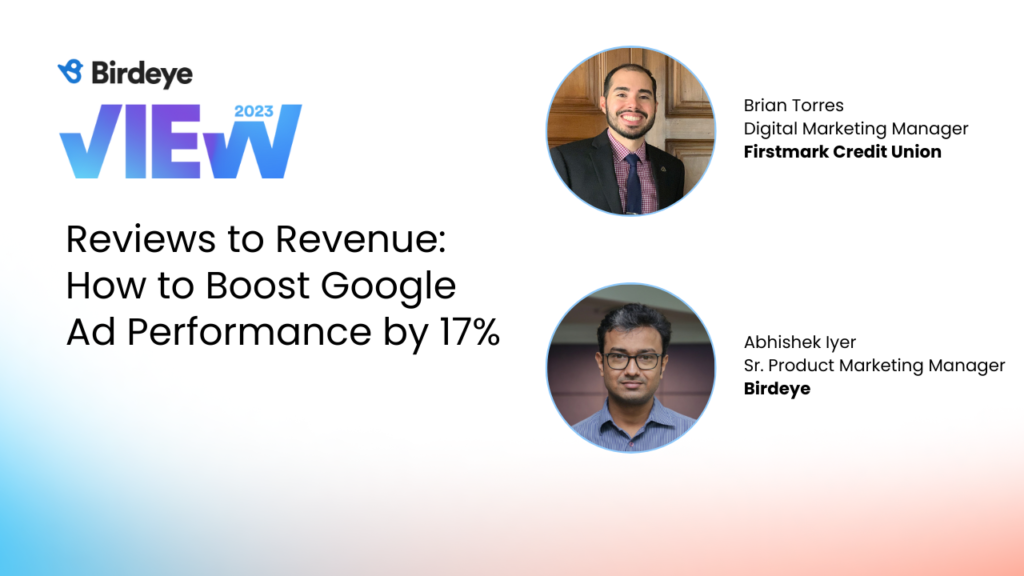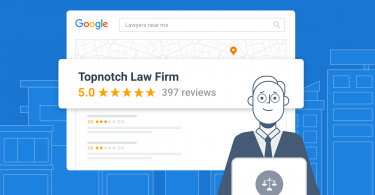Google ads are a top lead generation channel for local businesses. Implementing Google Seller Ratings (GSR) is a simple yet highly effective way to increase ad relevance and clickthrough rates.
Get ready for the return of the greatest gathering of reputation and social media experts at Birdeye View Conference 2024! With powerful sessions from top business experts and industry leaders in AI, social media, reputation, and customer experience management, this conference is a must-attend for any business leader. Register today to reserve your spot. Don’t miss your opportunity to outshine, outperform, and outrank your competition!
This blog details the panel discussion, “Reviews to Revenue: How to Boost Google Ad Performance by 17%” from Birdeye View 2023. The discussion features Abhishek Iyer, Senior Product Marketing Manager from Birdeye, and Brian Torres, Digital Marketing Manager at Firstmark Credit Union.
Key takeaways from the discussion
- Google Ads are crucial but the competition is high, making it tough to get good ROI. Google Seller Ratings (GSR) can give businesses a competitive edge.
- GSR displays your ratings in Google ads to build trust and relevance. This can increase clickthrough rate by 17% on average.
- To use GSR, you need at least 100 reviews in the past 12 months with 3.5+ stars average rating per domain. Birdeye helps you meet this requirement.
- Consistency in collecting and managing reviews is crucial for GSR success. It will also boost your SEO.
Ready to dive in? Watch or read the full conversation below.
Abishek: Hi everyone. Welcome to our session, Reviews to Revenue: How to Boost Google Ad Performance by 17%.
My name is Abhishek. I am a part of the product marketing team here at Birdeye. And with me today I have Ryan Torres, who manages all things digital marketing at Firstmark Credit Union. How are you doing?
Brian: Abishek, I’m doing great. Pleasure to be here. I’m looking forward to this conversation with you.
Abishek: Likewise. So, before we get into how we can improve Google ad performance, why don’t you tell us a bit about yourself first — about yourself and Firstmark Credit union.
Brian: Yeah, a little bit about Firstmark. So we’re based in San Antonio, Texas. We were a teachers-oriented education credit union, but we have since gone to a bigger audience within our city and our surrounding areas.
We were founded in 1932. We’re in San Antonio which is a pretty concentrated financial institution market, so digital marketing is able to give us those legs to get ahead and build our brand awareness.
So I’ve been in this role for…coming up on six months now, but have been part of the marketing team for about five years. So I just continue to learn, just keeping up with technology because I know advances every single day. It’s been a challenge but it’s been fun.
Abishek: Nice. And I’m looking forward to some of the insights on how you managed to get the most out of Google search ads.
But before we do that, let’s take a quick look at what Google search ads are.
So I’m pretty sure no one here is a stranger to Google ads. They are the top lead generation channel for local businesses, and it’s fairly easy to understand why that is.
First and foremost, I think Google search ads are extremely easy to set up. Anyone who has used Google search ads can attest to the fact that they are really, really simple to use.
Second, they can scale with your business. I think you can get started with just a few hundred dollars and you know that, based on how you grow, you can spend even millions if you want. There are very few channels that scale as you grow.
And lastly, Google search ads, unlike a lot of advertising channels out there, are measurable, right? You’ll know exactly what you are getting for the money that you’re putting into it.
And speaking of measurable, the average ROI that businesses see from Google search ads is somewhere in the range of 200%. Now, I’m curious to know, Brian, tell us a bit about your experience with Google search ads, how you got started and how it has evolved over the years?
Brian: Great question, Abishek. So, I’m relatively new to digital marketing, but I am head of my channel ads, kind of studying our past trends, dating back to 2019.
Like I mentioned before, we’re a teachers-based credit union in San Antonio. We have a lot of big players in our area — USAA, there’s other big banks, obviously. We have some of the top credit unions in the world that are in the United States within our city.
So we need Google ads. It’s a strategic part of our marketing campaign and our budget. As you cost, you know, it’s a very scalable goal.
We’re a billion dollar institution, but we have limited funds. We have to really use our members’ money very consciously to make sure that we’re doing the best to market and build brand awareness.
But Google ads is so important and vital to our marketing. We usually promote about 11 products — just the basic auto loans, checking accounts, mortgages, that kind of thing.
We have about 2500 keywords that we’re always using in order to kind of pinpoint if somebody looks at our credit unions or best credit unions in San Antonio or Texas, you know, we come up to that list.
So it builds that brand awareness for us and we continue to grow. We’ve been around for 90 years, but Google ads kind of gives us that relevancy that we need in order to stay competitive.
Kind of doing a little sneak peek though, with GSR, it was such an intriguing feature that Birdeye offered that we wanted to take advantage of it. I don’t want to give too much away, but GSR has been great already. We’ve had it for a brief time, but we need all the advantages that we can that we can get. So, GSR has been instrumental and we can’t wait to expand that.
But with Google ads in general, you know, as you said, it’s scalable. But as we continue to grow — and that’s really our strategic focus, you know, in the next five, ten years, obviously every company wants to grow — but that’s really going to be our main initiative.
So, Google Ads is going to be there and it’s going to help us achieve our goals.
Abishek: That’s great. And we will definitely talk about Google Seller Ratings in a bit. But before that, let’s talk about some of the struggles that businesses have been seeing with Google ads, especially of late.
Now, precisely because Google search ads has so many benefits, is precisely the reason why some of the businesses are struggling with Google ads, because what Google ads — or the prevalence of Google ads — has resulted in is that every business out there that is beyond a certain scale has started using Google ads.
And what that has resulted in, especially over the past 4 to 5 years, is an extremely high level of competition for certain keywords across industries, which has seen businesses experiencing higher costs, higher CPCs, higher costs per lead and higher costs per acquisition.
And at the same time, they are seeing lower conversion rates from Google search ads. So while Google search ads are non-negotiable for any business looking to generate leads online, however, it is getting more difficult as the years go by.
Does this match your experience, Brian, or has it been slightly different at Firstmark?
Brian: Yeah, looking at this, you know, this is the benchmark that has been provided. But I’m looking at and comparing with our numbers, we’re a little bit opposite and you know, that’s kind of a good thing for us.
So, you know, that clickthrough rate, I mean, come 2019, you know, we were kind of, you know, doing our thing. We didn’t know, really, what was going to be ahead of us.
But that cost per click and that clickthrough rate was about 17%. So, it’s a little opposite of what this is showing.
2020 is different there as well. For about four months we weren’t advertising at all digitally. We didn’t know what to do. We were kind of prepping, saving our money. Wondering, how long is this going to last?
And come September of 2020, we started to get back into it. We eased into it, our costs, we weren’t really spending as much. Still trying to prep. So that clickthrough rate probably was averaging about 14%.
2021, we were full steam ahead. We had a good plan in place. So that clickthrough rate kind of increased a little bit, but relatively the same — about 14%.
But we really haven’t started seeing some good numbers until 2022 and 2023. Those clickthrough rates are getting better. Those cost per clicks, coincidentally, you know, they were higher in 2019.
Throughout this 2019 until now, thankfully, we’ve seen that cost per click continue to go down. Our budget may vary, but relatively, like you say, we’re not going to be putting credit card Google ads out to everybody. We can’t compete with those big banks. So we’ve got to use our keywords wisely.
But to your point, we’re seeing some different trends on Firstmark’s end. It’s good for us. The cost per click, our conversion rates continue to get better.
Like I said before, GSR is instrumental in that regard. We’ve had it for a brief moment, but I know once we’ve had it for a year or two years, we’re going to continue to see great results.
I don’t know how much less our cost per click can get because right now I think it’s averaging about 45%. No, sorry, $0.45.
Our budget is relatively moderate. You know, we’re not spending like crazy in Google. But you know, it adds up as years go on. So we have to use it strategically.
But our cost and how much we’re actually getting, from impressions to cost to conversions, in these last four months, our conversions are getting double what they were starting this year and in years past.
So on our end, good trends. Conversions and cost per click are going down. So it’s just a little bit different than what you have here, but it’s good for us.
Abishek: Got it. And you have alluded to GSR a couple of times, so let’s not hold it back any longer. Let’s talk about what GSR is.
For most businesses out there that are struggling with getting consistently hired away from their Google ads, Google Seller Ratings can certainly help them achieve that.
So what is Google Seller Ratings? It’s a very easy to implement ad extension that businesses can enable within their Google ads account.
What Google Seller Ratings does is that it allows businesses to showcase their reviews and ratings within their Google ads. Like you can see here, a business will be able to showcase its reviews and ratings.
And what it does is that it increases trust and relevance of the ads. And by doing so, it can increase clickthrough rates on these ads by up to 17%. And this is Google’s own study. In our experience, we have seen businesses experiencing numbers that are way beyond this as well.
On average, by implementing Google Seller Ratings, a business can expect to see an uplift of up to 17% on their Google search ads.
Abishek Iyer
Now, how can you implement Google Seller Ratings? Now Google Partners with a few companies to feed in those reviews as a part of Google seller ratings. And Birdeye is one of them. By partnering with Birdye, you will be easily able to feed in those reviews and implement Google Seller Ratings within your Google ads.
Now, to do that, there are certain prerequisites that you will need to meet as a business, and these are the conditions that are required to go live with Google Seller Ratings.
First and foremost, to go live with Google Seller Ratings, you will need at least 100 first-party or 100 Birdeye reviews to be in place for you to qualify for Google search ratings.
These have to be at an average of 3.5 stars or above. We recommend that these are at least about four stars so that you go live without any hassle.
Third, these reviews are counted for the last 12 months. So at any given point in time for the last 12-month interval, you will need to meet these conditions, which is at least 100 first-party reviews and with a rating of 3.5 stars.
And lastly, this condition has to be met for every language and domain that you are running your ads for. So say, for example, you have five domains as a business. You will need to meet these conditions for each of those domains.
Similarly, if you are running ads on, say, Google.fr or Google.de, you will have to make sure that you have 100 French or German reviews for you to go live on those language-specific Google sites.
So that is how you can get started with Google Seller Ratings. Again, like I mentioned, Birdeye is one of the premium Google partners and we can help you meet this criteria fairly quickly, and help you go live with Google Seller ratings in a matter of weeks.
And I know Brian alluded to GSR already, and it seems like they have already seen some great results with Google Seller Ratings.
Brian, why don’t you talk about your own experience with Google Seller Ratings? How was life before GSR and after GSR? And are there any recommendations that you might have for businesses thinking about going live with Google Seller Ratings?
Brian: Thank you, Abishek. Great question. So I know I kind of jumped the gun and mentioned GSR a couple of times.
So, to talk about Birdeye as far as the platform in general, with Birdeye, you know, we joined back in 2019. So to get GSR, like you mentioned, you need at least 100 reviews with 3.5 stars or more.
So we created a platform — that was one of the main reasons we actually got with Birdeye was to increase our listings — or sorry, to clean up our listings — and increase our Google ratings. So our Google ratings, you know, averaged about 3.4. They weren’t the best, we wanted to get above four.
So with GSR, we needed to have those third-party reviews outside of Google. So Birdeye offers that platform, those microsites where we can collect our reviews.
Over the past four years we’ve increased our Google rating from 3.4 on average. For all of our locations we have currently, it’s about 4.4.
Brian Torres
With Birdeye, specifically on those microsites, we average 4.85 stars.
So GSR was a kind of an easy transition for us. We had built in the cornerstone with reviews and getting our reviews up on Google and Birdeye. So once GSR was actually an option, we knew we had the numbers to get this added to our platform.
Once the team let us know about it, being in a strict market — not a strict market, but a very concentrated and competitive market — GSR gives us that advantage above others.
As we know, reviews are very prevalent — in anything. You know, Yelp. You use Yelp or you Google a restaurant and see what the ratings are. I use it for more than restaurants. I use it for anything that I’m about to get a service on.
So that is the same for credit unions. As people take reviews, it’s very important, people have become accustomed to that being their buying process. When they see the reviews for this institution.
So thankfully we have 4.95 stars. Once anybody looks up Firstmark or they see a Google ad review, they’ll see that GSR rating on there.
Like I said, we’ve had it for a brief time. I’m kind of going to get in the weeds a little bit with numbers here. We have about 2 million impressions. GSR is not displaying on all of them, but on those, roughly 13%, we’re seeing this increase. So about a little less than 4%. We’re seeing them jump about 9.71% as you see here.
That cost per click, like I told you before, was like $0.45. With these specific ads where GSR is showing, our cost per click is $0.19. Like, it’s just crazy how much that actual impact has had. Compared to those ads that do not have GSR and just normal Google ads, that cost per click is about $0.92. That overall cost for those ads is $48,000 and the cost per clicks with GSR added is about $4,400. The price that we pay for GSR has already paid for itself.
GSR continues to improve our cost per click numbers. Our conversions are getting better. But, like I said, to that point of the reviews, people see reviews. That just helps us stick out because I can’t stress that enough: We have such competition here.
We need any advantage we can get and GSR is able to give that to us.
Brian Torres
Abishek: Absolutely. And these numbers are phenomenal. Before, without GSR, 3%. With GSR, 9%. That’s like a 300% increase, which is crazy.
So, yeah, great, great job implementing Google Seller Ratings and I hope you’ll see continued success with it.
But yeah, that’s kind of what we have for you. Let’s go with the final takeaways now.
So, Google search ads.
Any business that wants to generate leads online cannot do so without Google search ads. It is the top generation channel for local businesses.
Abishek Iyer
However, things are getting difficult as years go by. Not everyone is as lucky to have someone like Brian at Firstmark. So businesses are facing challenges getting adequate ROI from Google ads. One quick way to fix that is implementing Google Seller Ratings — which you can do with a partner like Birdeye.
And remember, to use Google Seller Ratings, you will need a minimum of 100 first-party reviews, 100 Birdeye reviews, with a minimum average rating of 3.5 stars in the past 12 months.
With Birdeye, you will be easily able to meet this criteria and go live GSR in a matter of weeks. And once you implement Google Seller Ratings, you can see your clickthrough rates go up and eventually you’ll get more bang for the advertising buck that you are spending on Google search ads.
So all things equal, if your clickthrough rates go up, you can expect a commensurate increase in your conversion rates and the number of customers that you eventually get from Google search ads.
So yeah, for any business that is spending a considerable amount of money on Google search ads, I would say Google Seller Ratings is a no brainer. And if you have any questions, feel free to reach out to us and we’d be more than happy to answer them.
In fact, I see a couple of questions here on chat already. Let’s go over them one by one. I think we have the time.
The first question is, will GSR show up on all my ads?
I think, Brian, you touched upon this. Can you walk us through this? What’s your experience been like?
Brian: Yeah, my experience was brief, but, you know, I was under the assumption that it was going to display on all ads. So it would kind of be a quick you know, we’d see all these huge conversions. The conversions have been great, but that’s not the case.
In the sample size that we’ve had, roughly less than 13% of our Google ads actually had GSR implemented. That 13% has been huge, but it does not display on all of the ads.
So that’s one thing to know. You know, the Google algorithm is hard to comprehend. I Like I said, we’ve had this a couple months, but as we have this a year or two years, it’s going to continue to get better. Our SEO will get better. This will just build upon itself. And the longer we have GSR, I have no doubt that this number is going to keep on going up and hopefully display on more ads.
Don’t hold me to it. But as I said, that 13% has been a solid number and I’m going to see that number hopefully go up as we continue to implement GSR year over year.
Abishek: Absolutely. And just to add a bit to that, like Brian mentioned, a bunch of things go into what shows up for people on Google. It’s a fairly opaque algorithm, like all things Google.
However, what we have seen is it depends a lot on the length of your ad copy. It depends on any other extensions that you might have enabled within your Google ads platform. And it also depends on the user.
So say, for example, if I have already searched for Firstmark Credit Union previously, chances are, it may or may not show me an ad with Google Seller Ratings the second time around.
A bunch of different things go into it. What we can only advise is that you enable Google Seller Ratings on as many campaigns and as many ads as possible.
And we have seen that businesses on average tend to see Google Seller Ratings show up on around 20 to 30% of all their ads. And even with that number, like Brian mentioned, you’ll definitely see an ROI that is multi-fold the investment that goes into Google Seller Ratings. So, yeah, great question.
Let’s take another one. I think we just have time for one more. Can Google Seller Ratings also help me with my SEO?
Great question. Unfortunately, the answer is no. Google Seller Ratings is a solution just for your paid ads. It is mainly to improve the ROI on your Google search ads and make them more effective.
Having said that, the fundamental or the back end behind SEO and GSR is the same, which is reviews. So work on your reviews, specifically Google reviews. Make sure that you generate an adequate volume of Google reviews on a month on month basis. Make sure that you respond to each and every review that you get. And yeah, as long as you do that, you can definitely expect an uplift in your SEO.
To cut a long story short, GSR does not directly impact SEO, but the reviews that power GSR definitely will. So keep up your online reputation management efforts.
But yeah that’s that. I think we are up on time. If you have any other questions, we’d be happy to answer them offline. But for now, thank you so much for joining us today. And yeah, Brian, any closing thoughts before we end this?
Brian: Yeah, you just mentioned the part about SEO.
Once we implemented Birdeye, that was one of our key goals — to increase our reviews and get better ratings. Since then, I can almost guarantee you that we’ve responded to about 99% of our reviews. We know that that plays a role in SEO.
Brian Torres
So if you have Birdeye already implemented and you have reviews, that’s very important. It just looks good for your brand. Responding to those reviews is very helpful.
Abishek: Absolutely. All right. I think that’s all we have for you guys today. Thank you so much for joining us. And we hope you enjoy the rest of the sessions at Birdeye View. Thank you so much.

Originally published









